« June 2013 |
Main
| August 2013 »
 July 25, 2013 | The Quest for "Playability"
July 25, 2013 | The Quest for "Playability"
We consider the Golden Bear state's Steve Sorensen one of the most talented new builders on the scene. After reviewing one of his asymmetrical 2-point "Sprite" mandolins a couple years ago, we couldn't resist commissioning the build of a personal signature version, our own blueburst Sprite JM. It's a terrific instrument, and Sorensen's career trajectory is one to keep track of; we anticipate a significant impact on the global stage of premium builders.
We have the privilege of bringing you some of the thoughts and philosophies on maximizing a mandolin's tone from his bench in this week's Tips and Tricks column.
Enjoy!
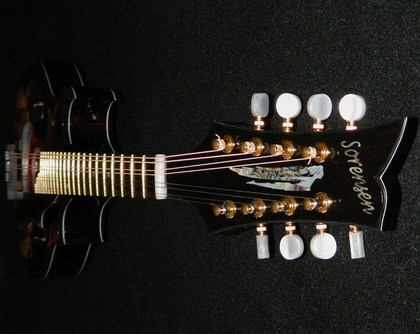
The Quest for "Playability"
Steve Sorensen
As a builder, I'll admit, it is fun to make instruments that are visually attractive . . . I guess you could call that "eye candy". But the ultimate goal is to create that elusive mix of traits which make a mandolin, "Easy to play and hard to put away."
The importance of "Playability" and understanding what makes an instrument feel comfortable and attractive for hours and hours of play time comes from a blend of essential common features and a few individual preferences that are both simple to list and hard to achieve.
At the most simple level, ease of play is directly tied to how much or little work your left and right hands need to do to generate the musical tones you hope to move from inside your head out into the world. Every mandolin player has heard about the finger-busting string height played by bluegrass legend Bill Monroe. Top bluegrass players tend to pick with great vigor, so having strings off the neck help avoids "rattin' out" -- those buzzy-fuzzy tones that happen when strings are not able to cleanly vibrate after they are picked. But the need for extremely high action to cover up flaws in the mandolin's structure and set-up should not be tolerated.
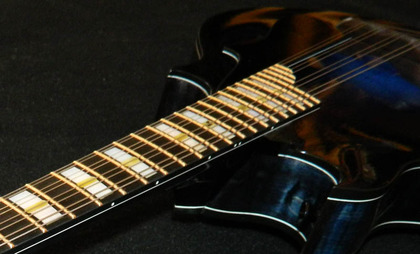
Keys to getting clean playing and easy noting at a relatively low action include:
Fret Dressing and Leveling. Every note should play cleanly at every fret when picked lightly and remain clean when driven by an aggressive, hard pick-stroke even when string height at the 12th fret is set at or below 1/16th of an inch. In addition, fret ends should not ever be noticeable to the sides of your fingers.
The Neck. While I have often heard new mandolin players talk about the need for a bigger neck, I have seen that experienced players can quite easily grab a mandolin with a 1" nut and play with ease. The reality is that bigger does not make better.
There was great wisdom in the neck design of the pre-1920s Gibson mandolins which were narrow, slim and slightly "V" profiled. While you may find that your prefer a wider neck, you should grab every opportunity to play instruments from and modeled after those petit beauties from the period when the mandolin was the most popular instrument in the western world. You will likely find that once you are able to fret cleanly with a small neck, the desire for a bigger neck profile begins to fade . . .
The Nut and Bridge. Spaces between the courses of strings must be even and the spacing of pairs should be consistent. The most interesting missed trait of "easy to play" instruments is the individual string height coming off the nut: slight differences in the height of the two strings in a pair force your fingers to compensate by pressing harder or differently from note to note as you play. To check this, fret on the first fret and note how each string moves down as you press it with your finger . . . Both strings of each pair should clear the first fret with just a wee bit more space than you see under the second fret when you fret at the first fret and be exactly the same height above the frets.
String spacing must also be consistent at the bridge both between courses and for each pair. In addition, at first glance, it should be apparent that the bridge stands evenly and doesn't need to be "jacked-up" on one side or the other to achieve proper string height, and that with the feet of the bridge are evenly spaced from the centerline of the mandolin. In all cases, the feet of the bridge (or the full surface for full-contact bridges) should be flush with the top with no gaps or spaces between the base of the bridge and the top.
Tone, Response and Intonation. I'm sure you have noticed that skilled and experienced players will immediately make just about any instrument "sound like them". But the best instruments draw more music out of great players . . . That is, the quick, easy, consistent and melodious response of the instrument generates an increased focus and range from the player which does not happen (without forced effort) when the mandolin is tight, uneven in response across the neck, or inconsistent in the way it responds to the pick.
At the most basic level, once the bridge is properly placed, intonation should be correct at every fret of the fingerboard. Individual notes should not go sharp or flat because of the stretching that occurs as you fret or because of mechanical/structural problems with the instrument.
Of course, responsiveness and tone are where the real differences arise between "Acceptable", "Good", "Excellent," and "Extraordinary". The reason that there is such a huge range in pricing between entry-level and top mandolins is that it is quite easy to make an instrument that sounds like a mandolin . . . but extremely difficult to blend and adjust those features to create an instrument that is both consistent and wide-ranging in its response to the player.
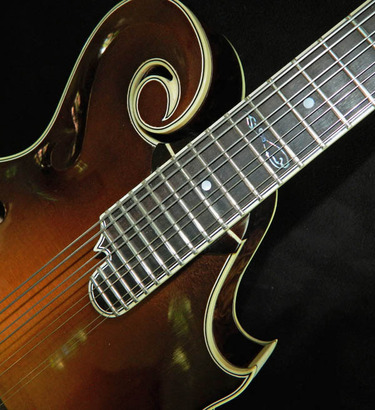
Clearly, the aspects of "Playability" touched on here could (and have) resulted in volumes of text and hours of discussion. My goal, as a builder and player, is to get you thinking about the tangible physical and tactile aspects of the mandolin which come together to make for an instrument that you can't help but keep playing.
I have experienced the distress of having a top player pick a few notes, smile kindly and hand back an instrument with a gentle, "Yeah man . . . cool." and also felt the elation of watching music legends, reluctantly pick a few notes, start into a tune, stop to grab a chair, then stay and play and play and play. I've realized that the only thing better than watching player pick, stare in wonder, then continue playing is when I get that feeling myself -- when I realize the instrument is pulling more from me than I knew I had and makes me wish I could just keep picking forever. That's why it's called playing!
If you are a new player, be bold about asking for a chance to play many instruments. As your knowledge, experience and skill increase, so will your ability to discern what makes an instrument truly playable for you. With that growing knowledge and confidence will come the thrill of finding the mandolins that are, "easy to play and hard to put away."
Steve Sorensen, Luthier
Sorensen Mandolin & Guitar Co.
Visit website
steve@sorensenstrings.com
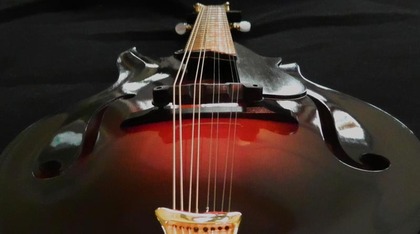
Posted by Ted at 5:15 AM
 July 18, 2013 | Pentatonic Scales; a whole new level!
July 18, 2013 | Pentatonic Scales; a whole new level!
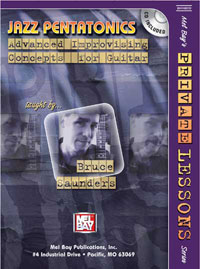 We mentioned this book over six years ago, Berklee professor and Austin, Texas based jazz guitarist Bruce Saunder's book Jazz Pentatonics (Mel Bay Private Lessons Series) as a great source for digging into the concept of advance Pentatonic scale use. Every folk musician knows the power of the pentatonic, five little notes and formulaic traid-plus-benign-notes capability. Mandolinists are prone to imprison themselves to just the simplicity of the Pentatonic scale in the key(s) of the song itself, beginning and most advanced, as well. We mentioned this book over six years ago, Berklee professor and Austin, Texas based jazz guitarist Bruce Saunder's book Jazz Pentatonics (Mel Bay Private Lessons Series) as a great source for digging into the concept of advance Pentatonic scale use. Every folk musician knows the power of the pentatonic, five little notes and formulaic traid-plus-benign-notes capability. Mandolinists are prone to imprison themselves to just the simplicity of the Pentatonic scale in the key(s) of the song itself, beginning and most advanced, as well.
The great Bebop musicians, 'Trane, Diz, Bird, were able to take these scales further, base them on upper extensions of the chords. If you have drilled these scales into your frets, you can take the next step of injecting them into your music as a way of voicing the upper chord extensions of some juicy chords. If you improvise these 5 notes with certain 7th chord variations, you can voice melodically, 9ths, 11ths, and 13ths, without thinking 9ths, 11ths, and 13ths.
Below are sample Pentatonic "opportunities" for Maj7, Min7, Dom7, and m7b57 chords. Especially effective in modal jazz where the song sits on a chord for several measures, these can bend the ear in an interesting but tastefully appropriate way. We've listed the 7th chord variation, the "Old School" Pentatonic scale used, and a new and improved "Upgrade." We've also noted the chord tones you infer by using the particular scale.
One suggestion, have another player comp the chord in a background first, or use some sort of "Band in a Box" software program or iReal B iPad app to generate an accompaniment. Once you get comfortable with one or two chords, play along with some familiar changes like a 12-bar blues or Rhythm Changes.
Open your ears and have fun!
Cmaj7
Old School: C Pentatonic C D E G A
Upgrade: D Pentatonic D E F# A B
You get: 9, (3), +11, 6, 7
Relation to root: Plus one step
Cm7
Old School: Eb Pentatonic (Cm Pentatonic) Eb F G Bb C
Upgrade: Bb Pentatonic Bb C D F G
You get: (7), (1), 9, 11, (5)
Relation to root: Down one step (up m7)
C7
Old School: C Pentatonic C D E G A
Upgrade: Bb Pentatonic Bb C D F G
Better Upgrade: Gb Pentatonic (Alt chord) Gb Ab Bb Db Eb
You get: b5, b13, b7, b9, +9
Relation to root: Plus diminished 5th (tritone)
Cm7b5
Ab Pentatonic Ab Bb C Eb F
You get: b13, b7, (1), (3), 11
Relation to root: Plus m6
Also: FFcP Pentatonic
Further:
Jazzed Pentatonics
Enhanced Pentatonics; What Goes Up Must Come Down.
Pentatonic revisited
Tetrachordal Approach to Major Scale Modes
Lateral Tetrachords
Posted by Ted at 5:08 AM
 July 11, 2013 | Best of JM: Respect the Silence
July 11, 2013 | Best of JM: Respect the Silence
Enjoy the popular archive material below.
From August 27, 2009 | Respect the Silence
From ClassicalNotes.net, Peter Gutmann on John Cage and the Avant Guarde "The Sounds of Silence:"
"4'33" was Cage's favorite work. Written in 1952, it came at the exact mid-point of his 80-year life of discovery and culminated his exploration of indeterminacy, music in which some elements are carefully scripted with others left to chance. The year before, he had written his Imaginary Landscape #4 for 24 performers, each of whom adjusted the volume or tuning of one of a dozen radios; although the dial settings were exactly prescribed, the result depended upon the frequencies and formats of local stations. 4'33" was inspired by Cage's visit to Harvard's anechoic chamber, designed to eliminate all sound; but instead of promised silence Cage was amazed and delighted to hear the pulsing of his blood and the whistling of his nerves.
 Most music is trivialized by attempts to describe it. ("The melody is announced by the flutes...") That's not a problem with 4'33". Here's how one performance went: A tuxedoed performer came on stage, sat at a grand piano, opened the lid, occasionally turned some music pages but otherwise sat as quietly as possible for 4 minutes and 33 seconds, then rose, bowed and left. And that was it. Most music is trivialized by attempts to describe it. ("The melody is announced by the flutes...") That's not a problem with 4'33". Here's how one performance went: A tuxedoed performer came on stage, sat at a grand piano, opened the lid, occasionally turned some music pages but otherwise sat as quietly as possible for 4 minutes and 33 seconds, then rose, bowed and left. And that was it.
Although often described as a silent piece, 4'33" isn't silent at all. While the performer makes as little sound as possible, Cage breaks traditional boundaries by shifting attention from the stage to the audience and even beyond the concert hall. You soon become aware of a huge amount of sound, ranging from the mundane to the profound, from the expected to the surprising, from the intimate to the cosmic--shifting in seats, riffling programs to see what in the world is going on, breathing, the air conditioning, a creaking door, passing traffic, an airplane, ringing in your ears, a recaptured memory. This is a deeply personal music, which each witness creates to his/her own reactions to life. Concerts and records standardize our responses, but no two people will ever hear 4'33" the same way. It's the ultimate sing-along: the audience (and the world) becomes the performer.
Let's tackle a few obvious questions. Is this music? Sure it is - each sound has a distinct tone, duration, rhythm and timbre. Isn't it arbitrary? But so are all artistic conventions. Couldn't a 3-year old have written this piece? Perhaps. But did he? Did you?"
This was quite a historic moment in the development and definition of contemporary music, and not one that can ever be duplicated. What does it have to do with your playing? Let's use it to make a point about silence, or better, "musical space." As ensemble players, we often go out of our way to fill each performance moment with something musically interesting. Ever play with a lead guitar player who insisted on noodling the whole time, playing asymmetrically parallel to the melody? How about playing with a bass player that thinks he's Geddy Lee incarnate, and abandons the role of driving the band for distracting upper fret exploration? You might have played with a drummer the rest of the band nickname "Fill," because he feels punctuating the end of EVERY phrase is his enduring entitlement.
There is little more musicially satisfying than playing in an ensemble devoted to a healthy respect for sonic space. The goal should always be to make the other individual players of the group sound good, and there is no way to accomplish this without adequate silence. It can be as radical as sitting out a chorus or two, or as simple as just not playing through every turnaround. Trading time in the limelight gives the audience a dose of textural "freshening," and it makes players listen sensitively to each other. Interesting things happen during this silence, and we aren't talking about the peripherals of air condition, crowd conversations, or creaking doors mentioned in John Cage's 4'33". It's the impact on the music itself that is so remarkable when that breathing room between musicians is developed.
Does this problem plague your band? Challenge the other members by interrupting during practice and quizzing each other who is playing what. Stop and ask your piano player what's going on in the kick drum, or ask the guitar player what's happening in the right hand of the keyboardist. Simply disciplining yourselves to pay attention to these small details can make your ensemble sound better than ever.
Be the "Silence."
Further:
Plays Well With Others...
Ensemble Sensitivity: Corps playing
Playing with a drummer
Building off silence
Posted by Ted at 5:44 AM
 July 4, 2013 | Master Class with Jim Hall
July 4, 2013 | Master Class with Jim Hall
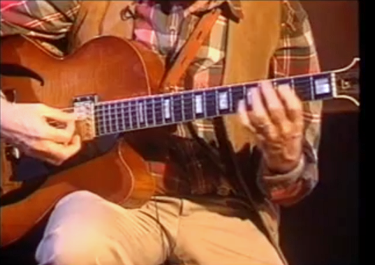
Though the mandolin is its own animal, we can pick up a lot of playing technique from a good jazz guitarist. Concepts of tone, picking articulations, and of course general musicianship, all can be of the artist palate we can share, and one of the best to glean ideas from is guitar legend Jim Hall.
Start with that pure tone, the smooth, robust fundamental that is the cornerstone of his sound, even the acoustic mandolinist can strive to pull fluid round sound with pick angle and left hand phrasing. His 56 minute YouTube video is pure gold and worth your time if not for his insightful bag of tricks, just to hear him play.
Enjoy!
Video link: Jim Hall - Jazz Guitar Master Class
Sure, we don't have the extra two strings, and even if you're wielding a 5-string, limited in comparison to the wider range of the guitar, but take note of how Hall exploits the entire length of the fretboard. Check out the variety of pick articulations, as well is introductory concepts of mode building. A favorite is his description of basic 12 bar blues as "A conversation--2 questions followed by an answer." Strip it down to that you can organize your blues soloing into a coherence any audience can connect with intuitively.
More Jim Hall music.
Further:
Guitar to Mandolin
Closing in on Bluesette
Raking it in. Autumn Leaves Pt. 2
Jim Hall on Johnny Carson
Posted by Ted at 8:07 AM

Disclaimer: In the 'Information Age' of the 21st Century,
any fool with a computer, a modem, and an idea can
become a self-professed 'expert." This site does not
come equipped with 'discernment.'
|



